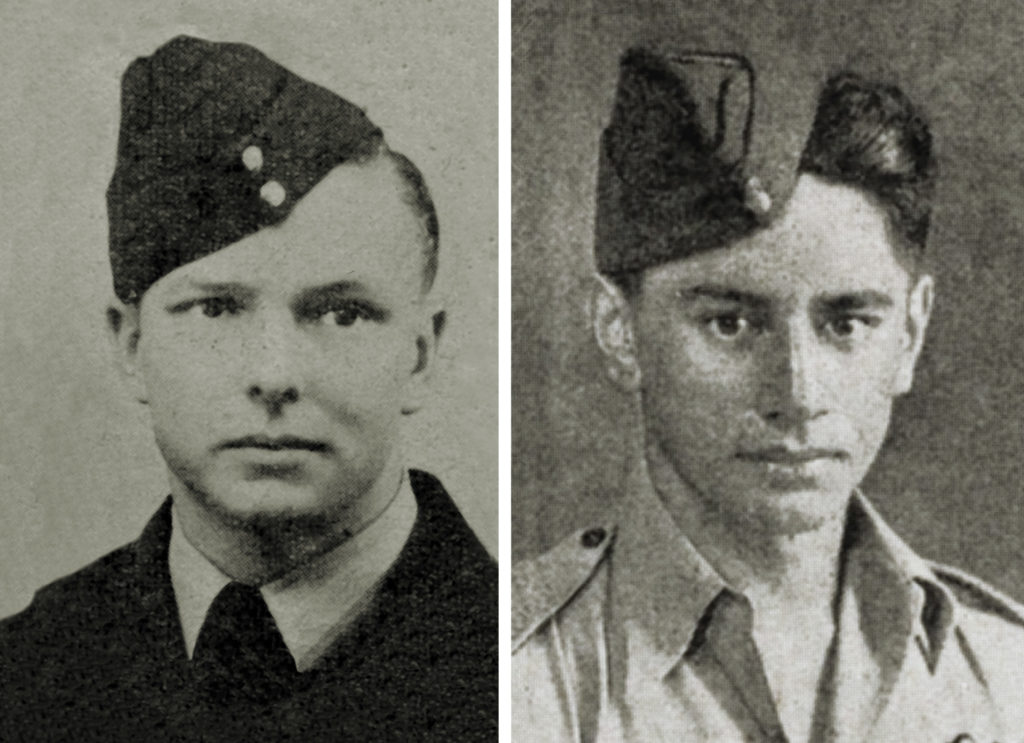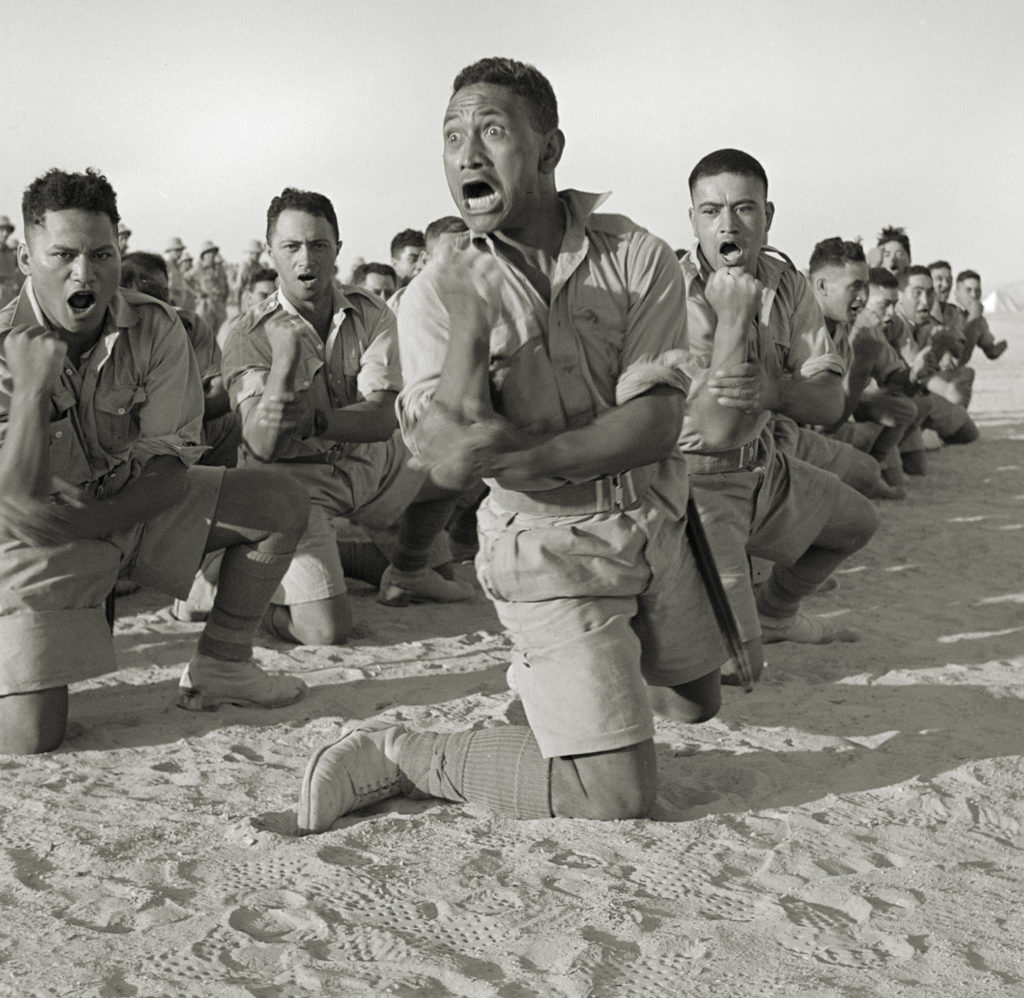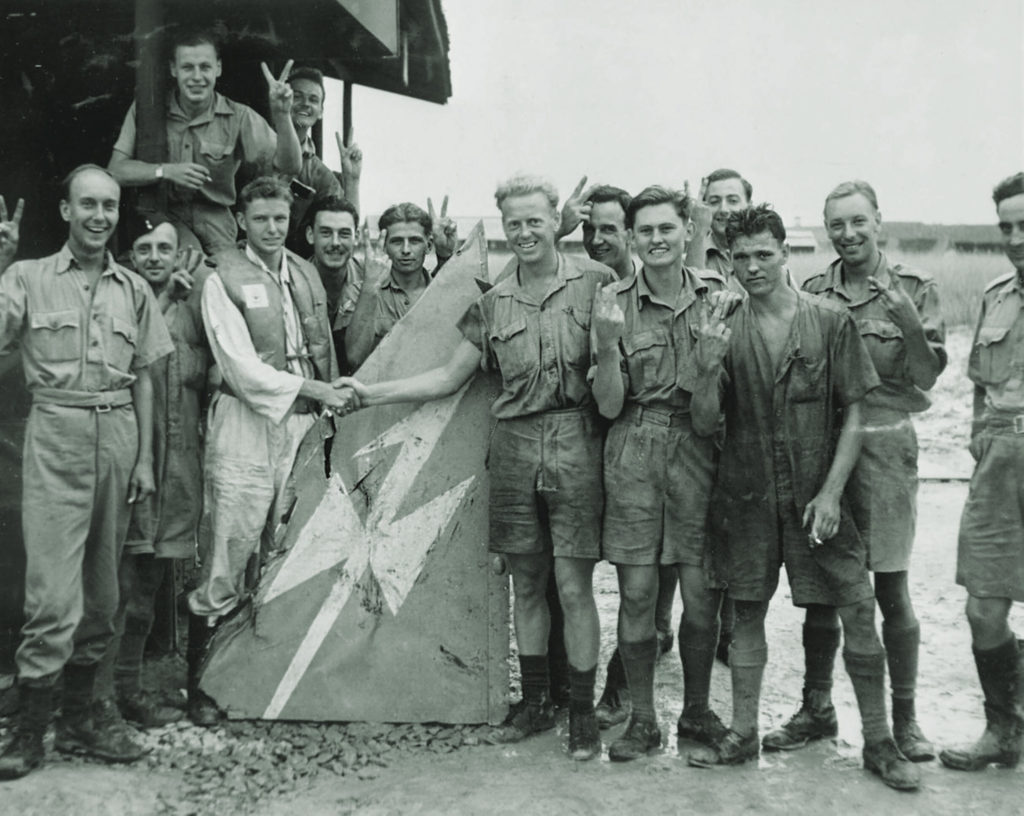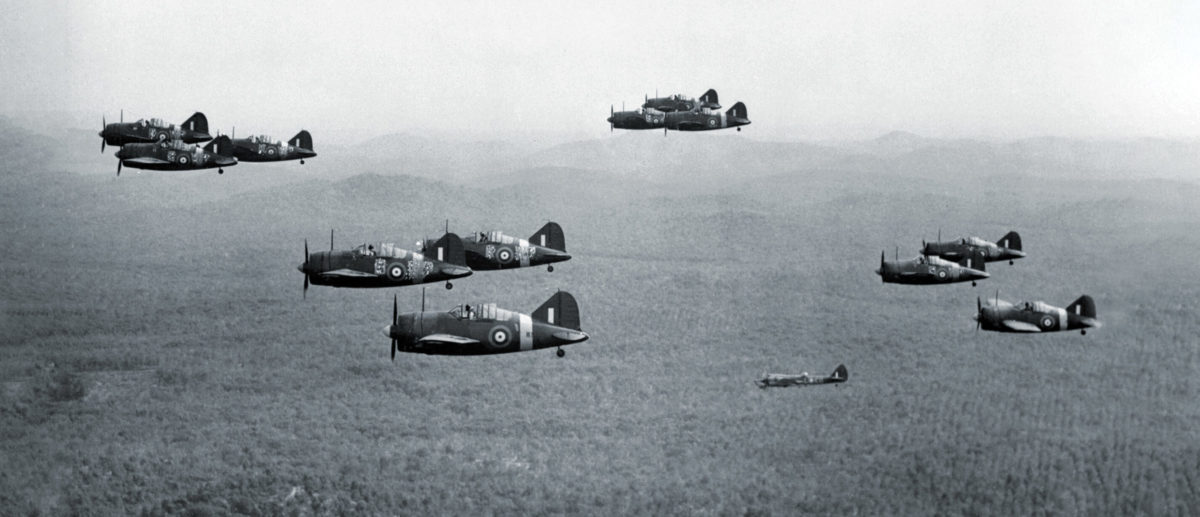Since the last of a series of wars between British colonists and native Maoris ended in 1872, white residents of New Zealand came to respect their fierce warrior neighbors as better to have fighting alongside them than against them. It was perhaps inevitable that a Maori would overcome British prejudice to qualify as a pilot, but Bert Wipiti stood out during World War II as the conflict’s only Maori fighter ace.
Born in New Plymouth on the North Island on Jan. 16, 1922, Herbert Samuel Wipiti graduated from New Plymouth Boys High School and became a refrigerator service man until war broke out. On Jan. 18, 1941, two days after his 19th birthday, he enlisted in the Royal New Zealand Air Force.
Best Friends
Enlisting on the same day was Charles Thomas “Charlie” Kronk. During training the two young Kiwis quickly became best friends in spite of (or perhaps because of) their striking differences. A clerk before the war, Kronk had been born in Kohwrakahi, Taranaki on the other side of North Island on July 28, 1918. Tall, fair-haired, and blue-eyed, Kronk was a star athlete in school and had graduated at the top of his class.
Bert and Charlie underwent flight instruction at Levin, Bell Block and Ohakea airfield. By the time they qualified as flight sergeants the two were inseparable. Both were extremely pleased when they were assigned to the same unit, No. 243 Squadron at Kallang airfield outside of Singapore. Wipiti also found a fellow Maori, Pilot Officer Terrence Bernard Marra, on the squadron roster.

Organized on March 12, 1941, 243 Squadron was officially a Royal Air Force unit, but its pilots were New Zealanders and its equipment was the Brewster B-339B Buffalo, an export version of the F2A-2. The F2A was the U.S. Navy’s first monoplane fighter with retractable landing gear and an enclosed cockpit, but the British found its performance inferior to that of German fighters and sent most of the 170 planes they purchased to the Far East, where they expected them (wrongly, it turned out) to have little trouble handling their likely Japanese opponents.
“A Born Leader”
Wipiti and Kronk made an early impression on the new squadron with their keenness to master anything with wings, as Sgt. Rex A. Weber recounted:
“Bert Wipiti was a born leader, his standard of conduct was impeccable. Bert and Charlie were sent up to do aerobatics—maybe they had ten flying hours on the Buffalo to their credit. Yet that day, in the blue skies over the airport, they gave us one of the great aerobatic displays. Seasoned aces from the Battle of Britain came out from the crew room to watch, the show was so good.”
The Japanese invasion of Malaya on Dec. 8, 1941 (December 7, Hawaii time) was accompanied by an onslaught by modern warplanes that shocked British Commonwealth airmen as it swept away their air power. By January 1942 No. 243 Squadron was broken up and its Buffalos distributed among other squadrons. The young Maori was about to pit his warrior spirit against that of an armada of flying samurai.
On Jan. 10 Wipiti and Kronk, both sergeants, were on patrol when Wipiti spotted a Mitsubishi Ki.46 high speed reconnaissance plane from the 81st Koku Sentai (air regiment) photographing Singapore’s defenses. “I slipped down from above and gave him a burst in his motor,” Wipiti laconically told a reporter afterward. The damage he inflicted slowed the enemy plane down enough for Kronk to dive down and then come up under it.
Shared Victory
“I kept firing until all my ammunition was gone,” Kronk said. “She was burning all the way to the ground, but the [Japanese] seemed to think that they could land her. But just as she flattened out she seemed to burst into flames all over and an enormous sheet of flame shot up and she disappeared into the treetops.” The two friends shared credit on 243 Squadron’s first aerial victory of the war.
The next few weeks saw the Allies driven back under relentless enemy pressure. Marra was credited with a Nakajima Ki.27 fighter on Jan. 16 and Kronk downed a Kawasaki Ki.48 bomber on the 20th. On the morning of the 21st six patrolling Buffalos of 243 Squadron were jumped by Nakajima Ki.43 fighters of the 64th Sentai and the formation leader, Flt. Lt. Mowbray Garden, suffered damage to his left wing. Wipiti, flying Sgt. Geoffrey B. Fisken’s Buffalo W1847 WP-O, fired into a Ki.43’s wing root and saw it go into a dive when its wings came off. Sgt. Maj. Hideo Tatsumi was killed.

The next day the Japanese navy made an appearance as Mitsubishi G3M2s of the Genzan and Kanoya kokutais (naval air groups) bombed Kallang. A few Buffalos got into the air, only to be engaged by escorting Mitsubishi A6M2 Zeros of the 22nd Air Flotilla Command, killing sergeants Victor Arthur (who was flying W1847 at the time) and Mervyn J. F. Baldwin. The only Allied success in the raid came when Wipiti shot down one of the Genzan Kokutai bombers.
The next four days saw the Commonwealth units struggling to support the ground troops being outmaneuvered and driven inexorably back on Singapore. On Jan. 26, the Japanese 96th Airfield Battalion and its equipment landed at Endau on the east coast of Malaya, aiming to restore the airfields at Kahang and Kluang to operational status.
The British responded by scraping together an attack force from what was available: Vickers Vildebeests and three Fairey Albacore torpedo bombers of Nos. 36 and 100 squadrons and a few RAAF Lockheed Hudsons. As the first wave of hopelessly obsolescent Vildebeests sallied forth at 2:00 p.m. Flt. Lt. Garden led 243 Squadron’s Buffalos up to escort them, while surviving Buffalos from Nos. 21 and 453 Squadrons covered the Hudsons.
A Fierce Struggle
An hour later the Allies reached the beachhead in clear weather—and were met by Nakajima Ki.27s of the 1st and 11th sentais. Garden’s Buffalo was hit, but he claimed one of the “Type 96 fighters” and nursed his plane back to Kallang while his wingmen tried to strafe the enemy barges. Plt. Off. James M. Cranstone claimed a “Zero.” Wipiti was credited with a third fighter destroyed. Marra claimed to have “probably” downed a “Messerschmitt Me 109,” but he had more likely been shooting at either a Hawker Hurricane or at a Nakajima Ki.44, a brand-new type that was still under evaluation when Capt. Yasuhiko Kuroe reconnoitered the scene of the air battle in it and returned undamaged.
Despite the fighters’ efforts, the Allied bombers were slaughtered and the 11th Sentai’s claims for the day came to two Hudsons, two biplanes, five Buffalos and two Hurricanes shot down for one of its Ki.27s returning damaged, while the 1st Sentai claimed six biplanes for the loss of 1st Lt. Toshiro Mizotani’s Ki.27, from which he parachuted safely.
Early the next morning Wipiti and Kronk flew an uneventful reconnaissance flight, their last with the decimated 243 Squadron before it was disbanded and its surviving aircraft and pilots passed on to No. 453 Squadron. As their situation became untenable, Kronk flew one of the few flyable Buffalos to Palembang, Sumatra on Feb. 7.
Losing a Friend
Wipiti took a boat to the island a few days later, but his vessel was sunk. He was in the sea half a day before making it to shore. Kronk contemplated commandeering a plane, flying back to Singapore and trying to find Wipiti, only to see the plane he’d had in mind destroyed in a Japanese air raid. Kronk returned to his tent close to tears and found Wipiti there, resting in his cot. Singapore surrendered to the Japanese on Feb. 15.
Still eager to fly and fight, Wipiti and Kronk volunteered and were accepted to fly in the Royal Netherlands East Indies Air Force, which had its own supply of Buffalos, but which was no more successful than the British in preventing Japanese landings in Sumatra and then Java. Taking a train to the southern coast of Java, Wipiti and Kronk boarded a ship for Ceylon (now Sri Lanka). From there they traveled to Calcutta and joined No. 67 Squadron RAF at Alipore, which since its retreat from Malaya had replaced its Buffalos with Hurricanes.
On March 27 Wipiti was gazetted for the Distinguished Flying Medal for his outstanding service in Singapore. As the Japanese advanced through Burma, however, his stint with 67 Squadron was anything but auspicious.
On May 29, 1942, Kronk was returning from a routine patrol when he performed a roll over the airfield, but his Hurricane stalled and crashed. Wipiti wrote Charlie’s parents of his tragic death and how much their friendship had meant to him. He was also in contact with a girlfriend back in New Plymouth, writing that she would be very much a part of his postwar plans if he survived it.
Transferred to Britain
With his fellow Kiwi gone, Wipiti found himself subjected to incessant degradation from his British colonial squadron mates over his skin color. It got to the point that his superiors at 67 Squadron decided that he needed a change of venue and transferred him to Britain.
Arriving in England in late March 1943, Wipiti served in several units and was promoted to warrant officer before finally being assigned to No. 485 Squadron, RNZAF at Biggin Hill in August, and found himself among friends and countrymen. In fact, 485 Squadron’s emblem included a Maori holding a taiaha—a traditional quarterstaff—
and the unit motto was “Ka Whawai Tonu,” Maori for “We will fight on.”

Wipiti was now flying the most coveted fighter in the British Commonwealth—Supermarine Spitfire Mark VC JK769, upgraded to LF Mark IX standard with the replacement of its 1,415-hp Rolls-Royce Merlin 46 engine with a supercharged 1,720-hp Merlin 66. He would need such a flying thoroughbred for the opposition he faced across the English Channel: Messerschmitt Me 109Gs and Focke-Wulf Fw 190As of the Luftwaffe’s battle-seasoned Jagdgeschwader (fighter wing) 2 “Richthofen” and JG 26 “Schlageter.”
Wipiti’s dogfighting success resumed on September 16 during Ramrod 223, RAF code for a short-range bombing attack. In this case, 485 Squadron was escorting six Martin B-26B Marauders of the U.S. Ninth Air Force against the airfield at Beaumont-le Roger when Me 109s and Fw 190s tried to get at the bombers. No Marauders were lost in the ensuing fight, but it was another matter for the fighters.
Plt. Off. John A. Houlton, in Spitfire MH350 OU-V “Butch II,” teamed up with Wipiti to drive down an Me 109 25 miles southwest of Beaumont, returning with a favorable impression of his partner: “Bert was a bundle of energy intent on getting to grips with the enemy under any or every circumstance.” Flt. Lt. Bruce E. Gibbs claimed another Messerschmitt. F/O Murray Metcalfe was credited with an Fw 190 at 5:45 p.m. but was hit by another Fw 190 about 15 minutes later and crashed in a cow pasture near La Ferté Fresnel. He was buried at Ecorsei cemetery on the 18th. The only German claim in the fight was a Spitfire 15 miles northeast of Lisieux by Unteroffizier Dominik Kraigher of the 4th Staffel (squadron) of JG 2, which reported no casualties of its own.
His Last Mission
Oct. 3, 1943 saw 485 Squadron on escort duty again, this time for Ramrod 258, a strike by Douglas Boston IIIs on enemy installations at Crèvecoeur-en-Auge. They were met over the Somme Estuary by Fw 190A-6s of 5th Staffel, JG 26 and in the ensuing low-level melée Wipiti was again credited with an enemy fighter in a team effort, this time alongside Sgt. George C. Couper, “borrowing” Johnny Houlton’s Spitfire MH350.
The Kiwis did not return unscathed. F/O James E. Mortimer damaged an Fw 190 but as he made for home at 500 meters altitude west of Haincourt his Spitfire, MH490 OU-P, was struck by anti-aircraft fire from the 14 SS Panzer Grenadier Regiment. Mortimer’s plane gave out. He crashed off the coast and in the course of the night the tide drove his dinghy up the Somme estuary in enemy territory. Over the next 11 months he evaded capture with the help of the French Resistance until rejoining the Allies on Sept. 2, 1944.
Somewhat more fortunate was Sgt. Neville E. Frehner, whose engine cut out as he returned over the Channel. He bailed out 15 miles south of Dungeness, Kent and after bobbing in his dinghy for 45 minutes he was picked up by a Supermarine Walrus rescue plane. Soon after his shared victory, George Couper became separated from Wipiti and was jumped by an Fw 190 that badly shot up his plane—he barely managed to nurse it back to base.
Bert Wipiti’s Spitfire JK769 was last seen going down off Cayeux-sur-Mer during the fight. The Focke-Wulf pilots of 5./JG 26 claimed three Spitfires in that area, two being credited to Leutnant Helmut Hoppe at 3:47 and 3:50 p.m. and one by Oberfeldwebel Adolf Glunz at 4:00 p.m. Hoppe reported one of his victims going down 10 to 15 kilometers west of Cayeux, most closely matching the location of Wipiti’s demise. The other German claims might have applied to Couper and Frehner, though both made it back. Hoppe was eventually credited with 25 victories when he was killed during a raid on his airfield at Epinoy by Spitfires of No. 411 Squadron, Royal Canadian Air Force on December 1.
If one counts aerial victories by fractions the way most did during World War II, Wipiti’s tally would have totaled four and a half. By World War I standards, in which shared victories were most commonly counted as one for each participant, he would have had a hand in the destruction of six, making him an ace. In any case, Bert Wipiti had lived and died in the highest Maori traditions. His remains were never found, but a street near the New Plymouth airport bears his name.





